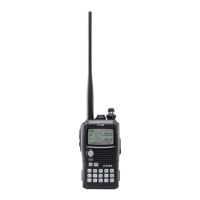■ Transmitting
✍ NOTE: To prevent interference, listen on the channel be-
fore transmitting by pushing and holding [SQL]
qSet the operating frequency.
(pgs. 18, 19)
• Transmission is available on the 144
MHz/440 MHz amateur bands only.
• Select output power if desired. See
the section at right for details.
w Push and hold [PTT] to transmit.
• Tx/Rx indicator lights red.
• S/RF meter shows the output
power level.
e Speak into the microphone
using your normal voice level.
• DO NOT hold the transceiver too close to your mouth or speak
too loudly. This may distort your speech.
r Release [PTT] to return to receive.
■ Transmit power selection
The transceiver has two output power levels to suit your op-
erating requirements. Low output power during short-range
communications may reduce the possibility of interference to
other stations and will reduce current consumption.
➥
Push and hold [LOW](3) for 1 sec. to toggle the transmit
output power between High and Low.
• “LOW” appears when the low power is selected.
WARNING! NEVER continuously transmit the transceiver for long periods of time. When the transceiver is used for continuous
prolonged transmission at high power, the transceiver radiates heat to protect itself from overheating and transceiver’s chassis
will become hot. This may cause a burn.
AVOID operating the transceiver in a situation that will obstruct heat dissipation, especially if the transceiver is operated with
an external power supply. Heat dissipation may be affected, and it may cause a burn, warp the casing or damage the trans-
ceiver.
Tx/Rx
Microphone
indicator
[SQL]
3
LOW
A/a

